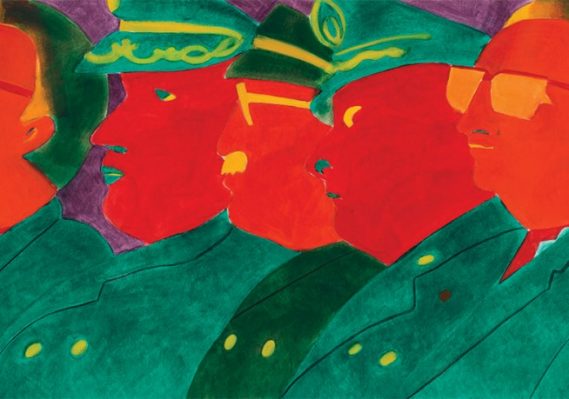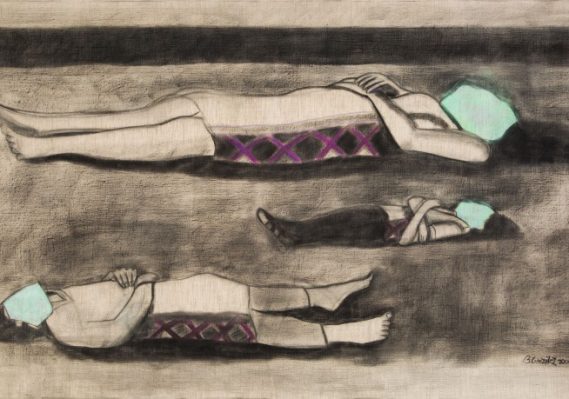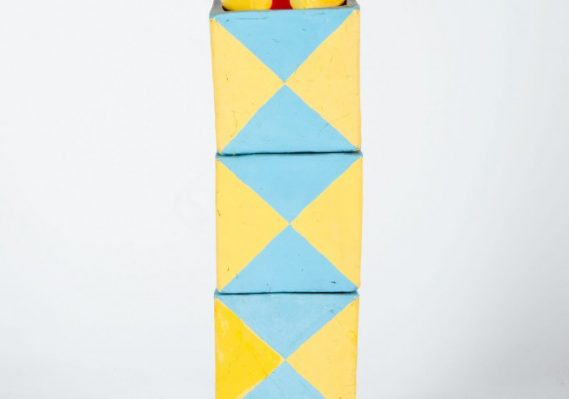
Oil on paper. 29 1/2 x 78 inches.
Collection Pérez Art Museum Miami, gift of Jorge M. Pérez
April 19 – Sept. 1, 2019
Pérez Art Museum Miami
1103 Biscayne Blvd.,
Miami, FL 33132
305 375 3000
pamm.org
Beatriz González: A Retrospective will be the first large-scale U.S. retrospective of the work of Bogotá-based artist Beatriz González (b. 1938, Bucaramanga, Colombia). At 81, González is not only an internationally celebrated Colombian artist but also one of the few extant representatives of the so-called “radical women” generation from Latin America. Despite the fact that it spans over six decades of intensive research, her groundbreaking production is, for the most part, unfamiliar to audiences in the United States. One of the most comprehensive displays of the artist’s work to date, this retrospective seeks to remedy this lag by presenting approximately 150 works, with examples from the early 1960s through the present, all of which embody the full scope of González’s oeuvre.

Charcoal and pastel on canvas. 48 9/16 x 82 1/2 x 1 3/4 inches.
Collection Pérez Art Museum Miami, museum purchase with funds provided by Jorge M. Pérez
The purpose of Beatriz González: A Retrospective is thus to display the full breadth, range and sophistication of the artist’s practice while seeking to dispel misconceptions about its position in the larger context of both Colombian and international Postwar art. Achieving this goal, however, entails rejecting upfront the generalized view of her work as a regional manifestation of international Pop Art in favor of a more nuanced interpretation of her practice vis-à-vis the cultural context from which it emerged. Working in Bogotá, and thus impervious to the emergence of a Pop Art movement, Gonzalez’s aim was not to celebrate postwar consumer culture but rather to investigate Colombian middle-class taste as well as the popular desire for and consumption of well-known European artworks. Declaring herself “a provincial painter,” she called into question the subordinate relationship between marginal localities such as Colombia and the hegemonic centers of artistic and cultural production represented by Europe and the United States. Her work thus embodies both a reaction to this uneven relationship as well as a fresh starting point. From this point of view, González’s objective does not end with the predictable (and rather exhausted) critique of representation implicit in any form of appropriation; her project, instead, is grounded in a broader assessment of the state of culture in her homeland and its relationship to the persistent legacy of colonialism.

Enamel on pottery. 38 9/16 x 7 13/16 x 7 13/16 inches.
Collection Pérez Art Museum Miami, museum purchase with funds provided by Jorge M. Pérez
Beatriz Gonzalez: A Retrospective will offer an expansive look at the artist’s unique and influential practice. Organized in a loose chronological order, the exhibition will include the artist’s most iconic works, many of which have rarely been seen outside of Colombia. In this way it will trace the different stages in González’s creative and intellectual explorations of mass-media images as vehicles for her extremely personal approach to representing key facets of Colombian society and its relationship to Europe and the United States. These range from two-dimensional oil on canvas paintings, drawings, silkscreen prints, and curtains, to three-dimensional recycled furniture (beds, tables, night tables, cribs, armoires), and everyday objects (trays, TVs, cigar boxes). The works will be culled from the artists’ personal collection as well as from public and private collections in Colombia, the United States and Europe.
In addition to her pioneering work with images recycled upon furniture and other supports, the exhibition also brings to light Gonzalez’s political production of the last three decades when she systematically chronicled the violence perpetuated by “la violencia,” her country’s decades long civil war, with an increased focus on indigenous, rural and displaced communities. While continuing to draw primarily from newspaper images and art historical sources, her recent paintings have become more complex in terms of composition as well as the use of collage to paint-in images taken from diverse media narratives and sources. While always innovative and unpredictable in terms of subject matter and artistic strategies, the depth and intensity of Gonzalez’s sui generis approach to individual and collective grief is unparalleled in contemporary art.
![Beatriz González. Gratia Plena (Tocador) (Full of Grace [Vanity]), 1971. Enamel on metal assembly on furniture. 59 x 59 x 15 inches. The Museum of Fine Arts, Houston, museum purchase funded by the 2007 Latin American Experience Gala and Auction](https://premierguidemiami.com/wp-content/uploads/2019/08/bg_peinadorgratiaplena_72dpi_0-569x399.jpg)
Enamel on metal assembly on furniture. 59 x 59 x 15 inches.
The Museum of Fine Arts, Houston, museum purchase funded by the 2007 Latin American Experience Gala and Auction
Major national support for the exhibition is provided by The Diane and Bruce Halle Foundation.
At PAMM, this exhibition is presented with lead individual support from Karen H. Bechtel and William M. Osborne. Additional gifts from Patricia and William Kleh, Estrellita and Daniel Brodsky, Sylvia Pope, Nedra and Mark Oren, and Cecilia and Ernesto Poma are also gratefully acknowledged. Support from Morgan Stanley and PAMM’s International Women’s Committee in addition to the Miami-Dade County Tourist Development Council, the Miami-Dade County Department of Cultural Affairs, the Cultural Affairs Council, the Miami-Dade County Mayor and Board of County Commissioners have also made this exhibition possible.